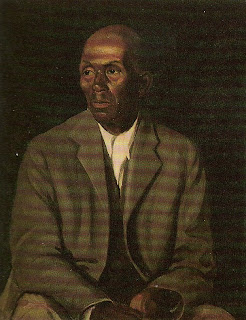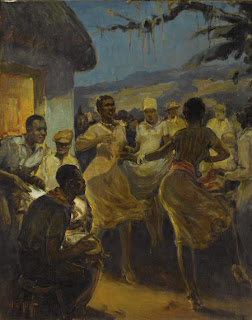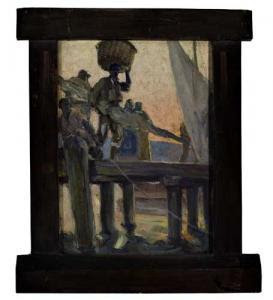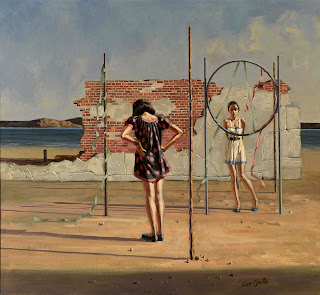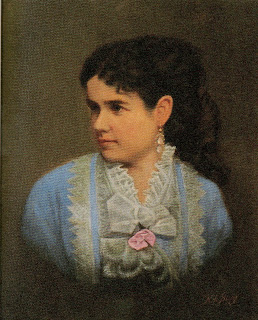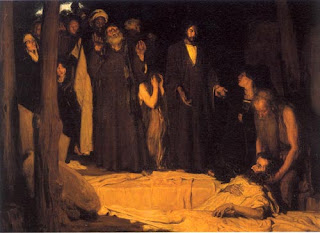
Henry Ossawa Tanner "Raising of Lazarus" 1897, Musee' de Orsay Paris, France
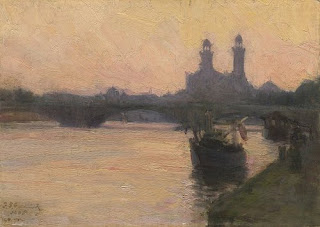 Henry Ossawa Tanner"The Seine" 1902 National Gallery of Art, Wash. D.C.
Henry Ossawa Tanner"The Seine" 1902 National Gallery of Art, Wash. D.C. Well the "three" (as I dub them) Tanner, Bannister, and Duncanson. I call them that because in the way I personally learned about them. I got familiar with Tanner first in high school. Seeing the " The Banjo Lesson" in my first art history class back in the 11th grade. He is the primary figure in African American art of the late 19th and early 20th century. The other two I learned about in art books much later. Bannister, who I didn't realize he was black until I finally saw him in an African American Art book. Ducanson was the last one. All three are first in some regards in American art breaking down barriers for artist of color. Each opening the the door to some degree for the next, Duncansan to Bannister to Tanner...
Henry Ossawa Tanner
(1859-1937) was born in Pittsburgh, Pennsylvania. His father was a minister at a African Methodist Church and this religious upbringing would have great impact on his work and his own strong personal beliefs. His mother was a private school teacher. He was also the eldest of nine children. He made the decision to become artist at the age of 13 when he saw a artist painting in the park by his home.
He studied at the Pennsylvania Academy of the Fine Arts in Philadelphia under Thomas Eakins where he was the only African American. He maintained a relationship with Eakins through out his career and kept in contact with his fellow classmate Robert Henri, founder of the Ashcan school.
He struggled to find work and patrons in the United States and a later failed attempt to open a photography studio in Atlanta 1888, so in 1891 he left for Paris as a young man to escape racial prejudice and find success and acceptance. Soon after he started exhibiting in the Salon where he gained acclaim and 1897 he won the gold medal " Raising of Lazarus". He later went to Middle East to observe and study the environment from which his biblical subject matter derived.
He spent the rest his professional career in France. Tanner became an honorary Chevalier of the Order of the Legion of Honor, France's highest award of recognition. In 1927, he became the first African American full academician elected into the National Academy of Design in New York. He died in Paris on May 25 1937.

Edward Bannister "The Boat on the Sea"
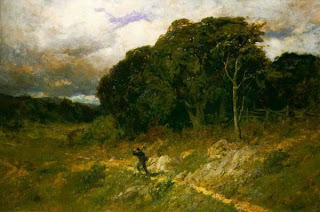
Edward Bannister"Approaching Storm" 1886
Edward Mitchell Bannister (1828-1901) was born in St. Andrews, New Brunswick, Canada. In the early 1850s, he moved to Boston, where he initially worked as a barber and later studied sculpture at the Lowell Institute. In 1867 He was fueled by comment made by the New York Herald stating "the Negro seems to have an appreciation for art while being manifestly unable to produce it " He soon became the first African American artist to receive a national award. In 1870, Bannister and his wife moved to Providence, Rhode Island. He was one of the three original founders of the Providence Art Club in 1878, which later inspired the Rhode Island School of Design; Bannister later became an instructor there.
Bannister’s painting encompasses aspects of nature in a naturalist manner. His work doesn't display the social or racial overtones that would characterize much of the work by African American artists who succeeded him. He is best known for his landscapes, but he also painted portraits. religious scenes, seascapes and still lifes. Bannister was known to be extremely critical of his own work and sometimes destroyed paintings that wasn't to his standard. However, he was a very prolific artist. He died in Providence in 1901 while attending a prayer meeting.

Robert S. Duncanson "Robbing the Eagles Nest" 1856

Robert S. Duncanson Landscape with Rainbow, 1859
Robert S Duncanson (1817 - 1872) he was born in New York, he was raised in Canada by his Scottish father . He moved back to the states to live with his mother in Ohio right outside of Cincinnati in the 1840's.
In his early career he was self-taught he learned by painting portraits and copying prints and was heavily influenced by the Hudson River School. He moved away form portraits to paint the landscape inspired by the prints in the journals of John Stevens and Frederick Catherwood, Incidents of Travel in the Yucatan
. Later he received a commission by abolitionist Charles Avery his career as a landscape artist took off.
Duncanson received a grant from the Anti-Slavery League to study in Europe in 1853. He also was the first African American artist to receive international recognition. He traveled painted abroad during his time painting the Scottish, Canadian and English landscape. He work was well received abroad the London Art Journal called him a master of landscape painting. He Duncanson work was widely collected during his time and was highly collected by the Queen of England. He died Dec. 21 1872.



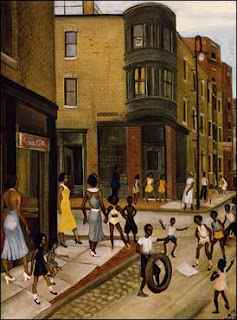


+Mending+Socks+The+Artist's+Grandmother+1924.jpg)



